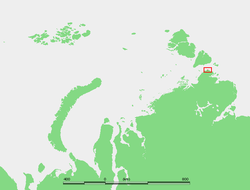Chelyuskin Peninsula
| Cape Chelyuskin | |
|---|---|
| мыс Челюскина | |

Location of Cape Chelyuskin at the northern end of the Taymyr Peninsula
|
|
| Location |
Krasnoyarsk Krai, |
| Coordinates | 77°44′0″N 104°15′0″E / 77.73333°N 104.25000°ECoordinates: 77°44′0″N 104°15′0″E / 77.73333°N 104.25000°E |
| Offshore water bodies |
Kara Sea Laptev Sea |
Cape Chelyuskin (Russian: мыс Челюскина) is the northernmost point of the Eurasian continent (and indeed of any continental mainland), and the northernmost point of mainland Russia. It is situated at the tip of the Taymyr Peninsula, south of Severnaya Zemlya archipelago, in Krasnoyarsk Krai, Russia. The headland has a 17-metre-high (56 ft) light on a framework tower.
Cape Chelyuskin is 1,370 kilometres (850 mi) from the North Pole. Cape Vega is a headland located a little to the west of Cape Chelyuskin. Oscar Bay lies between both capes.
The cape was first reached in May, 1742 by an expedition on land party led by Semion Chelyuskin, and was initially called Cape East-Northern. It was renamed in honour of Chelyuskin by the Russian Geographical Society in 1842, on the 100th anniversary of the discovery.
It was passed on August 18, 1878 by Adolf Erik Nordenskiöld during the first sea voyage through the North-East Passage.
In 1919 Norwegian explorer Roald Amundsen's ship Maud, left behind two men, Peter Tessem and Paul Knutsen, at Cape Chelyuskin after having made winter quarters there. The Maud continued eastwards into the Laptev Sea and the men were instructed to wait for the freeze-up of the Kara Sea and then sledge southwestwards towards Dikson carrying Amundsen's mail. However, these two men disappeared mysteriously and were never seen again. In 1922 Nikifor Begichev led a Soviet expedition in search for Peter Tessem and Paul Knutsen on request of the government of Norway, but Begichev was not successful.
...
Wikipedia

